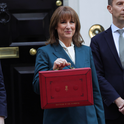How should the UK government choose which projects to invest in? How can it avoid making catastrophic mistakes? Labour’s new 10-year Infrastructure Strategy, published in June, shows the immense amount of public investment our economy needs and the sacrifices that will have to be made to fund it. Meanwhile, as the government sets out its noble intentions, HS2 is costing the Treasury more than £7 billion a year.
In June, the CEO and the responsible minister for HS2 told parliament that the unfinished high-speed rail project is over-specified, that costs are out of control and that construction is running years late. The most beneficial branches of HS2—which would have helped northern cites—have been withdrawn. What is left will duplicate existing railway lines.
When HS2 was first proposed in 2009, the appraisal, carried out according to the Treasury’s method, suggested that the benefits of the project might justify its vast costs. It also found that HS2 was a risky undertaking that would take many years to produce any return. It turns out that the costs had been understated and the benefits have withered. If spent on alternative public investments, the money invested in HS2 would almost certainly give a much better return. With demands for growth-enhancing investment outstripping the limited supply of public funds, it is particularly important to get this right. We cannot afford to go on wasting so much resource on unproductive initiatives for which there is lots of hand-waving aspiration, but not enough supporting analysis.
But the Treasury does have a method for doing just that. The department has a rainbow of official “books”, each with its own purpose: Red, Blue, Magenta, Aqua, Orange and now Teal. Not forgetting the Pink Book, which records statistics on the UK’s balance of international trade. We all watch the chancellor delivering budgets and spending reviews, but few study these supporting documents. That, however, is where the substance—and the devilish detail—is to be found.
HS2 was recommended for investment under the methodology of the Green Book. This particular Treasury book provides guidance on how to appraise spending on policies, programmes and projects. All government departments are supposed to follow it. In principle—if not always in practice—it determines what taxpayers’ money gets spent on. At the recent Spending Review, the Treasury published its audit of the Green Book, which the chancellor commissioned in January.
The Green Book has, in the past, suffered a bad rap. There is a common misperception that it is only about cost-benefit analysis; that it is a rigid and technocratic set of pseudo-scientific rules; that it gives undue weight to arbitrary monetary valuations; that it misses many important social dimensions of public policy; and that it is incapable of dealing with large, “transformational” proposals.
When lobbyists and politicians proclaim which investments are the right ones, they can be disappointed when Treasury funding is not forthcoming. Often, they blame the Green Book. One argument goes that looking at value-for-money tends to show good returns to investment in productive, high-income regions (such as London and the southeast) and poor returns in regions that need help (such as the north). But that is a case of “shooting the messenger”.
The results of the audit commissioned by the chancellor are thoroughly sensible. In essence, the audit found that the Green Book should be tweaked (naturally) but that in general it is just fine. The problems come not from the book’s analysis, but in the ways it can be used and misused.
The Green Book dates to the 1960s, when the UK Ministry of Transport introduced economic evaluation to help it select projects for investment. This was widely admired, and versions of the Green Book have been adopted in one form or another in many overseas administrations. It has been refined and developed as the underlying scientific disciplines have evolved. It was last updated in 2022.
This is how it works: the Green Book sets out a framework for the considerations to be made when deciding on government investment—a “five case model”. The cost-benefit analysis, one the five cases, is the economic dimension. It asks, as the Green Book itself says: “What is the net value to society (the social value) of the intervention compared to continuing with business as usual?” The second case is commercial: “Can a realistic and credible commercial deal be struck?” (meaning, who bears the risks for the investment and what are the proposed procurement arrangements?). The third case is the financial aspect. The book asks: “What is the impact of the proposal on the public sector budget in terms of the total cost of both capital and revenue?”. The fourth case relates to project management: “Are there realistic and robust delivery plans?”
These four sit with the fifth, strategic question: “What is the case for change, including the rationale for intervention? What is the current situation? What is to be done? What outcomes are expected? How do these fit with wider government policies and objectives?”
The reputation of the case that deals with economic value for money has been damaged because too much is expected of it. The question should not be “is it perfect?”, rather “is it useful?”. As Rachel Reeves’s audit points out, cost-benefit analysis is certainly not expected to grind out decisions like a machine. Sensibly used, this five-case model puts the weight of cost and benefits in a broader context.
Robust analysis of the government’s potential investments will expose assumptions for scrutiny. It will bring the best available evidence to bear, facilitating comparisons within and across departments of state. If done consistently, cost-benefit analysis can be helpful in guiding choices between, say, a road safety measure and spending that same public money on reducing risk of death in the health service.
Looking at costs and benefits systematically will protect against economically incoherent elephant traps, of which there are a number. It will help to stop the proponents of various schemes “double counting”, which is surprisingly difficult to avoid. A famous example is to claim financial benefits for the lower rate of crowding and faster journeys to a location achieved by introducing a new road or railway, as well as for an increase in the value of the land at that location. But the second is a consequence of the first; one can claim one or the other, but not both.
At the very least a Green Book appraisal forces proponents to write down and justify estimates of the basics, such as how much a project might cost, how many people might use it over the years and what the risks of the undertaking are. It is surprising how often people will assert that a project is a “good idea” without knowing these details. Often, a project’s champions will reel off an unquantified list of benefits from a scheme, giving little regard to how much public money it is going to cost, as if resources were free, and as if they could not be used in other, perhaps more beneficial, projects. Or even that they could remain in taxpayers’ pockets.
One criticism of cost-benefit analysis is that it can yield inequitable results, but there are ways of compensating for this, including to use a system of weighting. The chancellor’s audit recommends using unweighted analysis, which makes no pretence of dealing with equity, and then to discuss it as part of the strategic case and policy more generally.
A fair charge is that cost-benefit analysis is less plausible for large, “transformational” schemes. But this is a reflection of the fact that large schemes are difficult to analyse, requiring a lot of data. The issue is whether an imperfect appraisal using the best available evidence is more helpful than the alternative—speculation.
No cost-benefit analysis should be treated as definitive. But a poor estimated rate of benefit, in return for the costs at risk, should be heeded as a warning that there may be wiser ways of spending public money. That was the view of the unjustly neglected independent Eddington Transport Study (2006, for HM Treasury and Department for Transport). For these reasons Eddington was sceptical of high-speed rail in UK conditions. How right he was.
The recent review of the Green Book rightly promises more thinking on the knotty issue of the future. At the point of decision on a project, how should the government account for benefit or cost that is expected to accrue in, for instance, 20 years’ time? Typically, once serious spending has started on a project, delays in completion are catastrophic for the overall social value. That is not a weakness of cost-benefit analysis, it is a reflection of a fundamental dilemma. To what extent should any society sacrifice the benefits of current consumption so that investment can be made to deliver benefits in the future?
The review made some other sensible recommendations. A committee will be established to develop guidance where several projects are inter-dependent. An editorial shortening of the Green Book and its many supporting documents is promised; it is asking a lot of national or local government officials, who may or may not be trained economists, that they get to grips with the existing mass of material.
There is also a promise of more transparency, by publishing all the business cases for major projects and programmes. That can only improve the standard to which the work is done and it will facilitate holding government to account for decisions it makes—including explanations of its justification for proceeding with projects that don’t look like they represent good value for money. The problem in the past has not been too much reliance on mechanistic cost-benefit analysis. It has been a failure to show that available information on a proposed project has been given its due weight.
Success in the policy of investing to grow requires hard-headed analysis of the kind set out in the (revised) Green Book. This is how government can select the right projects for investment. We can no longer afford to squander resources on aspirational projects that do not have a firm, evidence-based justification.












